In June I participated in the IBACOS annual Alliance Innovation Summit, held this year in downtown Chicago. The lineup of speakers was excellent and, as you might expect, those attracted to a conference with “innovation” in the title tend to be seekers, thinkers, and learners—industry leaders trying to escape the box in some manner to find an edge. The group was thoroughly engaged and although I had a speaking role, I reveled in the opportunity to get off the podium for 95 percent of the time and simply be another one of the participants. Those of us who write, speak, and present frequently in the industry don’t do enough of that—just listening—and some, I suspect, never do. Perhaps because we’re supposed to be the experts, or at least we sell ourselves as such, we are afraid to be seen as just another student trying to learn, understand, and solve problems like everyone else.
There were some compelling questions raised both during and after presentations that provoked challenges and even disagreement—all perfectly in the spirit of the conference. It’s rare that anything on the leading edge of innovation is fully developed, totally fleshed-out, with hard data to support the new technique, strategy, or tactics. Those who demand to see the data prior to implementation will never take on the role of innovator because there will never be enough data to support a genuinely new direction. How could there be? Don’t toss that off lightly as merely a passing observation on the state of innovation because it is indeed a massive obstacle to process and product improvement, and most of us succumb to it without ever realizing it. Examples abound.
Not long ago I worked with a senior manager whose response to virtually every single improvement idea proposed by suppliers, trades, or his own people was, “But that’s not the way we do it here.” Oh really? Totally surprised to hear that. It got so bad that I wanted get him one of those Staples red buttons I keep on my desk that, when smacked, says, “Gee, that was easy!” but change it to “Gee, that’s not how we do it here!” so I could save him the trouble. I tried every way imaginable to help him, to the point of looking him right in the eye and stating, “The fact that your firm and every other builder in town does not do it the new way represents the very opportunity you seek.” If everyone already did it that way, how could there be an opportunity? By definition, anything new, different, or innovative represents something you do not do now. “We don’t do it that way” should have been music to his ears, yet he was totally deaf to it.
Innovation–or Basics?
A week after the conference, while working on a presentation for PCBC (aka, the West Coast builders show) about solving the trade shortage, during a long flight from Detroit to San Francisco, an interesting thought occurred to me. My talk on “The Chaos That Destroys Quality” at the IBACOS Innovation Summit was perhaps the only one out of 20 or so presentations at the event that wasn’t really about “innovation” per se. To give you an idea, the other major presentations that day focused on the “New Age of BIM,” “Smart Cities,” and “Housing Reinvented.” Each of those described genuinely disruptive technologies that, to adopt, would require major change in both thinking and operating practices. My presentation, on the other hand, was really “back to basics,” describing 20 specific fail points in the home building process, starting with business strategy and land/lot selection all the way through schedule, turnover, and homeowner management. (See list, below.) Just a few of these fail points, working together, create chaos that trashes quality, customer satisfaction, and profit.
Then I looked over the summary list of points I was making for individual builders trying to beat the trade shortage (as opposed to the industry trying to solve the broader problem). There was nothing really innovative about the list at all, just back-to-basics things that every builder can and should do. The fact that most builders fail on these points does not make them innovative. Would teaching a pilot how to land a plane undamaged constitute innovation? Would teaching a chef how to avoid food contamination be innovative? Sure, you might devise an innovative technique but still, most of it is merely basics.
This all came as a surprise to me because I have always thought of myself as more of a bleeding-edge kind of thinker without a lot of respect for traditional ways of doing things. I am attracted to almost anything new and edgy. Yet Lean process implementation, which constitutes the vast majority of my firm’s work that keeps five of us very busy, is at its most basic level about very elementary stuff. As my grandmother at age 103 once remarked, as I described again what I do for a living, “So basically, all this stuff you do is just a fancy way to get these builders and their suppliers and trades to talk to one another? And they pay you to do that?” Well yes, Granny, that’s pretty much it. Doesn’t sound too innovative, does it?
Take a look at the 20-point list again. It’s all about simply trying to get builders to do the right things, invest in high-return processes, and stop repeating the same mistakes over and over. Now juxtapose that with the innovative methodologies on display at the IBACOS summit. Is it possible that through innovation we could completely reinvent the process of home building and structurally avoid so many of the 20 pitfalls listed here?
Consider the current rage over self-driving, autonomous vehicles as a parallel. Being based in Detroit, I hear a great deal about this. When several noted advocates of these new technologies get together, what they describe is nothing less than fantastic. Eliminate driver control and just tell the car where you want to go, “Park within 100 yards of the Cupcake, Yoga, & Kick Boxing Emporium,” and off you go in complete safety. The recent revelations about Tesla accidents notwithstanding, excluding the driver eliminates the variation and thus removes most of the possibility for error that produces accidents. In time, there would be no need for stop signs or stop lights as the system would know on its own whether a stop or yield was needed. Roads and freeways will be able to carry far more vehicles with almost no delays. Now add to that taking the wheel out of the hands of the 14.68 percent (my estimate) of all drivers who are certifiable menaces and, well, I am cautiously looking forward to the day—I think.
Just recently, there was a lot of news about “3-D printing houses” and this, too, came up at the summit. Exciting stuff, although I still can’t figure out how they’ll differentiate between all the materials that go in a simple wall, including structural members plus exterior sheathing, plus an interior surface all sandwiched around ducts and wires and tubing, surrounded by an insulating material. That’s about 10 very different and specific types of materials that will have to be simultaneously printed. The programing and setup sounds more difficult than building using traditional methods, but I probably suffer from limited vision here. In September I will present at the Building Systems Housing Summit, in Asheville, N.C., and I wonder if structural printing will be a feature there yet.
Still Waiting, After All These Years …
I launched my post-collegiate career in manufacturing with U.S. Steel and Motorola, and later spent an entire year touring and evaluating more than 30 manufactured and modular housing companies for a national builder. I am a sincere advocate of using components wherever possible to reduce cycle time, labor input, and to control quality. Having said that, I have seen far more of these efforts fail than succeed in my day.
I vividly recall what Bill Pulte said in a workshop 27 years ago when he held up his fingers about half an inch apart and declared, “True application of manufacturing techniques in home building is a revolution about this far from happening since the end of World War II!” As of 2016, that’s a total of more than 70 years, and that’s still a good description of where we are as an industry. Bill was a huge fan of technology and continually pursued advanced techniques in home building, but he never sacrificed getting a product or process detail right in his quest for innovation. Are we on the cusp of a genuine upheaval in our approach to building homes? I suspect that those under 50 will help manage it, those under 40 will participate in the change directly, and the rest of us will watch it on TV while eating soft food in some institution, reminiscing about the good old days.
Let’s go back to the senior manager who was so hung up on his current methods and cite an example I mentioned in my Professional Builder column last month: ceiling trays. Between our team and a couple of trades, three alternatives were posed to replace the double-layered 2x12 trays. Option 1: Create them from 2x4 material and OSB, for about half the cost. Option 2: Omit the OSB, letting the drywall itself provide extra stiffening; again cutting the cost. Option 3: Build the trays right into the trusses. We didn’t get to fully price that last option because our senior guy killed all three alternatives as “not how we do it here.” Yet we know it would save a day in the schedule, a lot of labor, and would reduce site waste, so that’s a good start.
In my mind, Options 1 and 2 are no more than good, smart home building technique—that is, basics. Option 3 is tougher to define. In my home state of Michigan, almost everyone does build trays into trusses, so that would qualify as basics. But as we travel around the country, we rarely see this method used, and in some markets, they’ve never seen it at all. So in those locations, do we call this method innovation?
The Indictment
The night after that flight to San Francisco, I ran into Betsy Scott who runs the Housing Innovation Alliance and I described what I’d been mulling over. She immediately countered and suggested that no, since most builders don’t follow these proven steps for solving either complexity or the trade shortage, my process outlines do indeed qualify as “innovative” and thus a perfect fit for a conference on innovation. But let’s take the issue of solving the trade shortage for a moment, which includes requirements such as involving suppliers and trades early in plan and specification development, providing a complete and accurate bid package, a “gospel-quality” start package, and a “sacred schedule,” just for starters. This is innovation? If so, that’s one damning indictment of the building industry.
It would be perfectly consultant-ish to conclude by saying, “Yes! We need both innovation and basics to compete at the top level,” and it’s not hard to support that. But the cold, hard truth of the matter is, given the current state of operating practices in home building, I’d spend the majority of my time and money doing whatever it takes to get the basics absolutely nailed. That presumes, of course, that we know what the basics are. Maybe it’s time we all went back to school for some remedial training on that.
Back to Basics: 20 Sources of Complexity
- "Moth to the flame” business strategy
- Changes in land use/plot plan
- Changes in product, models, specifications
- Creeping elegance
- Inadequacies in standard plans, options, colors, selections
- Incomplete plans without working drawings, mechanicals, or sufficient detail
- Insufficient training for salespeople and design-center staff
- Incomplete house-bid packages for suppliers and trades
- Incomplete base contracts with detailed scopes of work
- Options selections and colors not 100 percent priced and agreed to up front
- Custom and/or structural options accepted without capacity in systems or processes
- Incomplete house-start packages for suppliers, trades, and field supervisors
- No respect for cut-off dates for options and selections
- Percentage of house cost done under VPO too high
- Poor relationships with municipalities that delay permits, inspections, approvals
- A loose schedule with continual changes, no predictability
- High turnover in suppliers and trades
- High turnover and inadequate training in both office and field staff
- Indecisive senior management
- Lack of comprehensive, proactive homeowner management: Day 1 through warranty
Advertisement
Related Stories
Off-Site Construction
Utah Passes Bill to Regulate Modular Construction at the State Level
Goals for housing innovation and affordability meet in the Utah's passage of a new bill that establishes a statewide modular construction program
Awards
Ivory Innovations Announces 25 Finalists for the 2024 Ivory Prize
The finalists for the prize demonstrate innovative, scalable solutions for advancing housing affordability
Business Management
AI in Home Building ... What Now? What Next?
Artificial intelligence is coming to home building. How can builders use AI in new-home construction? Start with this primer









